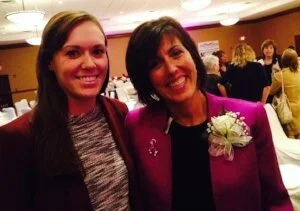Do you work with your total opposite?
They say opposites attract. But how do they stay connected?
As an intern working for my now business partner, Corey Jamison, I had a front row seat to a leader who was (and is) very (VERY) different from me. We are often at different ends of a spectrum when it comes to … well, everything. Work styles, communication patterns, love of pets (or not) and so on. When we first started working together, I thought I needed to become more like her: more exciting, more fun, more energetic, more spontaneous. I realized quickly that was never going to happen. Our differences as human beings, leaders, team members - are just too vast. An attempt to model myself after the leader I worked for just wasn’t going to happen.
And, fortunately, she knew that too.
We know intuitively that our differences make our partnership and our business stronger. But sometimes that can get lost in the day-to-day challenges of working with someone who is just so different from me. Over the course of the seven years we have been working together, I have found a few strategies to leverage our strengths. These strategies have also served me in many partnerships, emerging and long-standing ones.
Discover what you have in common.
What do Corey and I have in common? We both want the other to be successful. Starting with the shared interest of the others’ success creates a lot of space to be generous when work styles and opinions vary widely.
Don’t have the luxury of your partner or team member caring about your success? What do you have in common? Perhaps you both care deeply about the success of a new project, coming in under budget, signing new clients- whatever it is, find it and share it explicitly with your partner. Calling on your shared interest during difficult conversations or change is more likely to lead to a better outcome.
Do things together.
Doing things together gives me data about Corey’s worldview. Some of our obvious differences are:
Volume of words (she speaks 100 to my 10)
Organizational styles (as in, I’m organized, she’s not)
Color preference (she likes colors that unapologetically shout, I like the quieter ones)
Use of punctuation (she speaks in exclamation points and boldface type, I am fluent in consistent font sizes and styles and only use an exclamation point if the building is burning, and then only one)
I most often learn about how we are different by doing things together and seeing how these and other differences come into play.
Watching a TED talk, talking a walk, going to a networking event are all low risk opportunities to learn to work together that prepare us for the moments that depend on our high performing partnership to deliver an outstanding result.
Compatibility in a partnership or team is not the starting point, it is the goal. The ability to intelligently disagree with a person is a skill that is learned and developed over time.
Call on your strengths.
In our work as management consultants, we work with leaders and team to call on their strengths to inspire and lead teams. My top three strengths according to the Values in Action Character Strengths assessment are honesty, judgment and prudence. Corey’s are creativity, love and bravery. Not surprisingly, our full assessments are almost opposite.
Calling on our strengths gives us the tools to approach our differences with a solution-focused mindset. We are reminded of the ways in which we are able to build on each other’s ideas by bringing a different perspective that is far out of our common tendencies.
Working with you total opposite can be a fun and rewarding experience.


